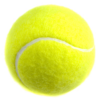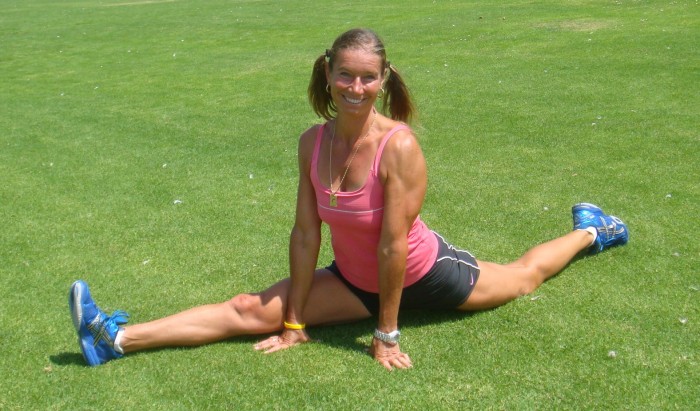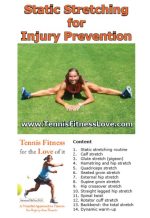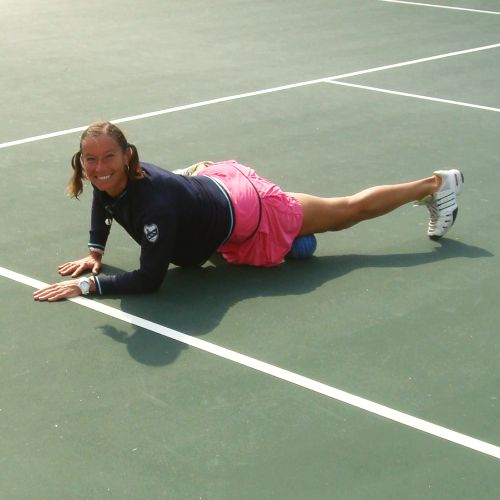The majority of people, and especially athletes, have their glutes shortened and too tight. The harder we train, the more demands on the glutes, and if we don’t take a good care of them, they get dysfunctional. While some may think sometimes that a tight booty is a good thing, not here, not now :-). If you want to perform at your maximum, you have to take care of those glutes.
There are many ways to care for your glutes, such as strengthening them for strength, power and explosiveness, making them evenly strong and flexible on both left and right side, deep tissue massaging them by a therapist or a myofascial release tool (rollers, balls, little firm balls, etc. My favorite is The Grid Roller), and of course, last but not the least, stretching.
Stretching is the simplest and quickest thing of all, so this glute stretch should be on your daily agenda without a compromise.
Tennis is a demanding sport on your muscular-skeletal system: your muscles, tendons, and joints are taxed tremendously with the quick direction changes and bursts of sprints and stops. The one-sidedness of tennis creates even more problems on a top of it.
The dominant side of your body gets much more work, even if you play a two-handed backhand. The serve, volleys, overheads, and forehands are hit with your dominant side only. Most of the players also prefer to run around backhands and hit forehands instead, which will add even more work to the dominant side.
Over time, this dominant side of your body gets stronger, bigger, and tighter. No amount of work in the gym will make it even, but it is a good idea to work hard to make the differences as small as possible.
In addition to changes in your upper body, there are things happening in your hips as well. You hit most of your forehands with an open stance and many backhands with a closed stance, so the muscles on your dominant side are used most of the time. And as mentioned before, you often choose to hit your forehands instead of the backhands, so that dominant hip gets really beat up.
Once you start having slight imbalances in your hips, then the mechanics of your running gait change even so slightly, but over time, you may encounter problems with your knees, ankles, feet, or your lower back.
Paying attention to your hips should become the highest priority in your fitness training. Keep them balanced with strengthening and stretching and always address one side at a time so you can feel the imbalances.
The best time for this glute stretch is directly after the tennis practice, because if any hip issues have been created, you can correct them right then, before the muscles get tight and make the imbalances even worse. Perform this glute stretch at least once every day. But preferably more: in the morning, after training and before you go to sleep. Until you feel like your hips are even and flexible.
Glute Stretch
Get down on the ground on your hands and feet with your glutes up in the air. Bend the left leg and bring your knee and the lower leg forward on the ground close to your hands.
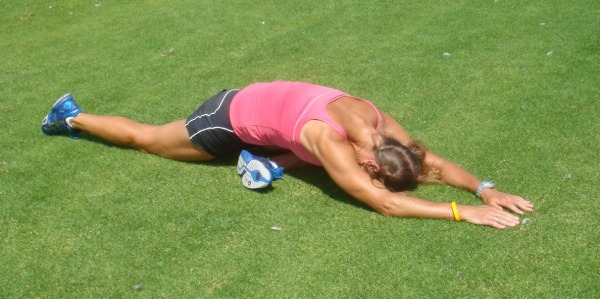
If you are very flexible, your lower leg will be parallel with your hands. If you are like most tennis players and athletes, your foot will be closer to your hip. Slowly fold down your upper body over the left leg, place both elbows on the ground, and relax your shoulders and the right leg. It will be tempting to tilt your hips to the left to relieve the pain or to get lower to the ground, but resist the temptations. Keep the hips even and parallel with the ground. If the pain is horrible, try to manage it with deep breathing. Focus, visualize how the tension leaves your body, and let go of the physical fight that you and your muscles do right now. Relax your neck and make yourself comfortable in the stretch.
Most of tennis players and athletes find this stretch difficult because of the tightness in the glutes. You may also feel tightness in your left inner thigh, knee, or the right hip-flexor. Breathe deeply and hold the stretch for one to two minutes, then switch sides. The goal with this stretch is to reach the ground with your left glute but without tilting the hips. With a regular practice, you will be able to do it.
Always start with the tighter side, then stretch the good side and return to the tighter side one more time.
Daily stretching and myofascial release of your glutes will keep your hips functional and as a result, your movement on the tennis court will be faster and more explosive. You will get to the balls sooner and hit shots that are more powerful, and your tennis game will improve.
And if you ever encounter any lower back discomfort or pain, you may get rid of it too when you get your glutes and hips functional again.
.
